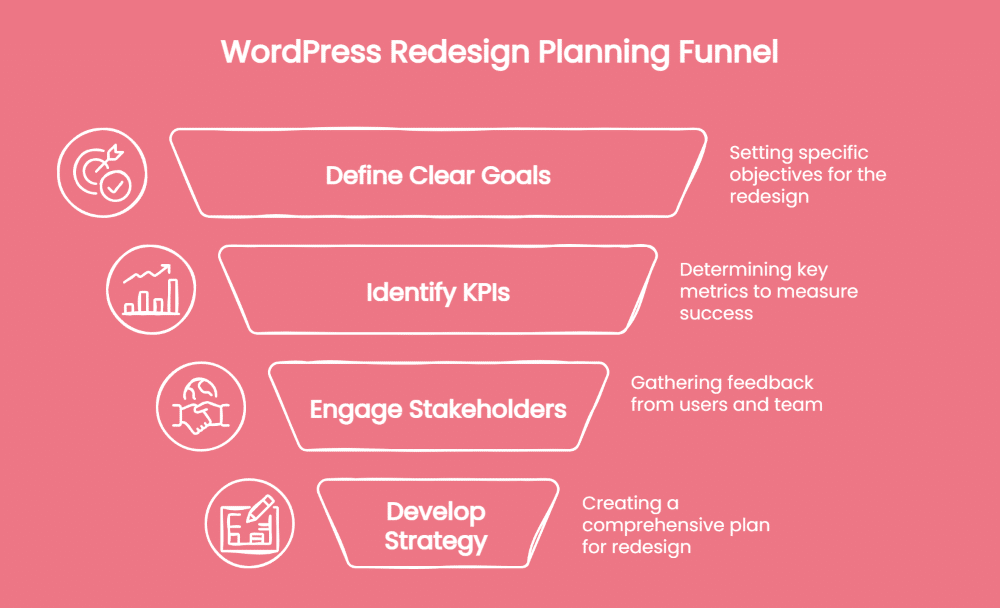TL;DR:
- A website redesign is crucial when your site shows declining performance, outdated design, or poor mobile responsiveness
- Australian businesses typically invest $3,000-$15,000 AUD for professional WordPress redesigns, with DIY options starting from $500
- Always back up your site and audit SEO before starting any redesign work
- Choose between customising existing themes, selecting new themes, or custom web development based on budget and goals
- Mobile-first design is essential – 68% of Australians primarily browse on mobile devices
- Preserve SEO rankings by maintaining URL structures and implementing proper 301 redirects
- Launch with a staged approach and monitor performance metrics for 30 days post-launch
A slow or outdated website sends the wrong message before you say a word.
Your WordPress site is often the first impression potential customers have of your Australian business. If it feels clunky, loads too slowly, or frustrates mobile users, you’re losing leads before they even see what you offer.
This comprehensive WordPress website redesign guide will show you how to transform your online presence while protecting your search rankings. A redesign goes beyond looks, turning your site into a digital asset that drives measurable business results.
How Do I Know If My WordPress Site Needs a Redesign?
Your website might be crying out for a makeover without you even realising it. But how can you tell for certain?
Start with a website performance audit. According to Google’s Core Web Vitals data, sites that load in under 2.5 seconds see 70% better engagement rates. If your WordPress site takes longer than 3 seconds to load, you’re already behind the curve.
Check these warning signs:
Your bounce rate exceeds 55%. This means visitors are leaving without exploring further – a clear indicator that something’s not clicking with your audience.
Mobile traffic converts at less than 1%. With Australian mobile usage reaching 87% in 2024, a poor mobile experience is costing you customers.
Your last design update was over 3 years ago. Web design trends and user expectations evolve rapidly. What looked modern in 2021 now appears dated and unprofessional.
WordPress Redesign Planning: Setting Your Foundation for Success
Before touching a single pixel, proper planning prevents poor performance. Let’s dive into the essential groundwork.
Collecting Website Performance Data (Google Analytics Setup)
You can’t improve what you don’t measure. That’s exactly why establishing baseline metrics is crucial.
Install Google Analytics 4 if you haven’t already. Track key metrics including page load times, user flow patterns, and conversion rates. Document your current organic traffic levels, top-performing pages, and primary traffic sources.
Keep in mind: this data becomes your benchmark for measuring redesign success.
Conducting a Comprehensive WordPress Website Audit
A thorough audit reveals both opportunities and potential pitfalls. Think of it as a health check for your digital presence.
Examine your site architecture – Review your content management system functionality, plugin compatibility, and current theme limitations. Assess your website’s accessibility compliance with WCAG 2.1 guidelines, particularly important for Australian government contractors.
Technical SEO elements need special attention. Check for broken links, missing meta descriptions, and duplicate content issues.
Setting SMART Redesign Goals for Australian Businesses
Vague goals lead to disappointing results. Instead, establish specific, measurable objectives.
Rather than “improve user experience,” target “reduce bounce rate from 55% to 40% within 90 days.” Instead of “increase sales,” aim for “boost e-commerce conversion rate from 2.1% to 3.5% by March 2025.”
Consider Australian market specifics. If you’re targeting local searches, include goals around “near me” visibility and Google My Business integration.
WordPress Redesign Cost Guide: Australian Pricing & Budget Planning
Let’s talk numbers – because budget determines your redesign approach and helps you decide between website redesign vs new website development
DIY WordPress redesigns using premium themes cost $500-$2,000 AUD. This includes theme purchase ($80-$200), essential plugins ($300-$800), and potential freelance help for specific tasks.
Professional redesigns from Australian agencies range from $3,000-$15,000 AUD for small to medium businesses, with specialised ecommerce website design Sydney services often commanding premium rates due to complex payment integration requirements. Enterprise-level custom development starts at $15,000 and can exceed $50,000 for complex functionality.”
But here’s what many forget: ongoing costs matter too. Budget for hosting upgrades ($30-$100/month), maintenance ($150-$500/month), and content updates.
Choosing Your WordPress Redesign Method: 3 Strategic Approaches

Not all redesign paths are created equal. Your choice depends on budget, timeline, and technical capabilities.
Method 1: Customising Your Existing WordPress Theme
This budget-friendly approach works when your current theme’s framework is solid but needs modernisation.
Start by updating to the latest theme version. Then customise CSS for visual refresh, optimise existing layouts, and add new functionality through plugins. This method preserves familiarity for returning visitors while improving aesthetics.
Cost-wise, expect to invest $500-$2,500 AUD, with completion in 2-4 weeks.
Method 2: Selecting and Customising a New WordPress Theme
Sometimes a fresh start makes more sense. Premium themes offer professional designs with built-in functionality.
Research themes specific to your industry vertical (a hypernym encompassing all business types). Consider multipurpose themes like Astra or GeneratePress for flexibility, or niche-specific options for targeted functionality.
Important: verify theme compatibility with WooCommerce if you’re running an online store, as WordPress functions as a robust eCommerce CMS platform. Check reviews from other Australian users for local payment gateway support including PayPal, Stripe, and Afterpay.”
Method 3: Custom WordPress Design Development
For unique brand requirements or complex functionality, custom development delivers exactly what you need.
This approach offers complete design freedom, optimised performance without bloated code, and scalability for future growth. However, it requires significant investment and longer timelines.
Australian agencies typically quote $8,000-$25,000 AUD for custom WordPress web development, with 8-16 week timelines.
Pre-Redesign Essentials: Protecting Your Website & SEO Rankings
Before making any changes, safeguard your digital assets. One wrong move could tank your search rankings or lose critical data.
Create comprehensive backups using UpdraftPlus or similar plugins. Store copies both locally and in cloud storage – redundancy prevents disasters.
Document all current URLs, especially high-traffic pages. You’ll need this for redirect mapping later. Export your SEO data including meta titles, descriptions, and schema markup.
Here’s something crucial: notify your email subscribers about upcoming changes. Transparency builds trust and prevents confusion when your site’s appearance changes.
WordPress Theme Selection & Installation: Best Practices Guide
Choosing the right theme sets the foundation for redesign success. But with thousands of options, how do you decide?
Prioritise mobile-responsive designs – they’re not optional anymore. Check theme ratings and update frequency; abandoned themes create security vulnerabilities. Verify compatibility with essential plugins like Yoast SEO, WooCommerce, or Contact Form 7.
For Australian businesses, consider themes supporting local payment gateways (PayPal, Stripe, Afterpay) and shipping calculators for Australia Post integration.
Installation requires a methodical approach. Always test themes on staging sites first – never experiment on live websites.
WordPress Website Redesign Implementation: Step-by-Step Process
Now comes the exciting part: bringing your vision to life.
Begin with homepage redesign – it’s your digital shopfront. Focus on a clear value proposition, intuitive navigation, and compelling calls-to-action. Australian users expect to find contact details, ABN, and physical address quickly for trust verification.
Next, tackle key landing pages. These hyponyms (specific page types) include service pages, product catalogues, and contact forms. Each needs optimisation for specific user intents.
Content migration requires careful attention. Don’t just copy-paste; improve readability, update outdated information, and enhance SEO elements during transfer.
Mobile-First WordPress Design: Australian User Expectations
Mobile isn’t just important – it’s absolutely critical for Australian audiences.
Design for thumb-friendly navigation. Buttons need 44×44 pixel minimum touch targets. Ensure text remains readable without zooming; 16px minimum font size works well.
Page speed becomes even more crucial on mobile. Compress images using WebP format, minimise JavaScript execution, and leverage browser caching. Australian mobile users on 4G networks expect sub-2-second load times.
Test across devices Australians actually use. iPhone dominates with 51% market share, followed by Samsung at 29%. Don’t forget tablet optimisation – many Aussies browse during commutes.
WordPress SEO During Redesign: Preserving Your Rankings
SEO preservation requires meticulous planning. One oversight could undo years of ranking progress.
Maintain URL structures wherever possible. If changes are necessary, implement 301 redirects immediately. Map old URLs to new equivalents, ensuring no broken links remain.
Here’s the thing: Google needs time to recognise changes. Submit your updated sitemap through Google Search Console promptly. Monitor crawl errors daily during the first month post-launch.
Transfer all metadata carefully. Page titles, descriptions, and header tags should migrate intact or receive strategic improvements.
WordPress Performance Optimisation: Speed and User Experience
Speed isn’t just about user experience – it directly impacts conversions and SEO.
Implement caching solutions like WP Rocket or W3 Total Cache. These plugins dramatically reduce server response times. Choose Australian CDN endpoints through Cloudflare or Bunny CDN for optimal local performance.
Optimise your database by removing post revisions, spam comments, and transient options. Regular maintenance prevents performance degradation over time.
Image optimisation deserves special attention. Use lazy loading for below-fold images, serve responsive images based on device capabilities, and compress without visible quality loss.
WordPress Redesign Launch: Going Live Successfully
Launch day requires military precision. A staged approach minimises risks.
Start with soft launch to the internal team. Test all forms, payment processes, and key user journeys. Verify mobile responsiveness across devices.
Schedule launch during low-traffic periods. For Australian businesses, avoid Monday mornings or Friday afternoons. Tuesday-Thursday, 10am-2pm AEST typically works well.
Monitor everything intensively for 48 hours post-launch. Watch for 404 errors, form submission failures, and unusual traffic patterns.
Post-Redesign Optimisation: Continuous Improvement Strategies
Launch isn’t the finish line – it’s the starting point for optimisation.
Implement A/B testing on key elements. Test different CTA colours, headline variations, and layout options. Let data, not opinions, drive decisions.
Gather user feedback actively. Install Hotjar or Microsoft Clarity for heatmap insights. Survey customers about their experience with the new design.
Regular performance audits keep your site competitive. Schedule monthly checks of page speed, mobile usability, and Core Web Vitals scores.
Common WordPress Redesign Mistakes: Avoiding Costly Pitfalls
Learning from others’ mistakes saves time, money, and frustration.
SEO and Traffic Loss Prevention
The biggest mistake? Ignoring SEO during redesign. Sites can lose 50% or more organic traffic through poor migration.
Always create comprehensive redirect maps. Never delete old content without careful consideration – it might be driving valuable long-tail traffic. Maintain internal linking structures that pass authority between pages.
Don’t change everything simultaneously. Google prefers gradual changes over complete overhauls.
User Experience and Conversion Optimisation
Prioritising aesthetics over functionality kills conversions. Beautiful designs mean nothing if users can’t complete desired actions.
Avoid removing features users rely on. If your contact form generated leads, don’t replace it with just an email link. Keep checkout processes simple – Australian consumers abandon carts when faced with complexity.
Test thoroughly before launch. What works on desktop might fail miserably on mobile.
Conclusion
A successful WordPress website redesign does more than refresh appearances — it strengthens your digital presence and supports long-term growth.
The most effective redesigns balance design, performance, and SEO so your site works for both users and search engines. Backing up before changes, testing on a staging site, and prioritising mobile performance are simple steps that protect results and reduce risks.
Your website represents your business around the clock. With careful planning, a methodical launch, and ongoing optimisation, it can become one of your strongest business assets.



